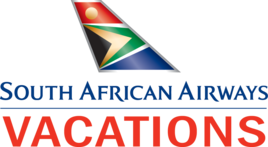On arrival in Johannesburg board your connecting flight to Windhoek, Namibia.
On arrival at Windhoek’s Hosea Kutako International airport you will be met and assisted to the car rental desk. Collect rental vehicle and drive into the capital city.
Overnight on a bed and breakfast basis at Elegant Guest House

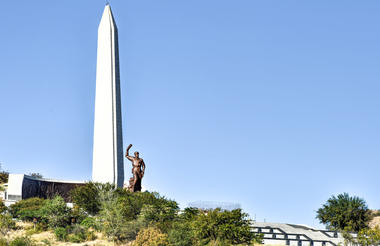
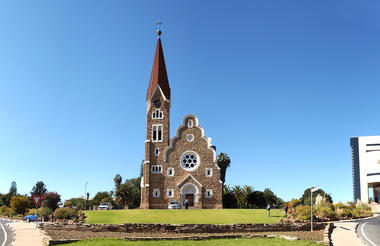
Departing Windhoek you head south towards Rehoboth, the traditional home of the Baster people. The Basters migrated north from the Cape and settled in this fertile area in the 1870’s. Their name derives from the word “bastard” and refers to their “mixed blood” (European and Khoikhoi) – far from being insulted by such a reference the Baster people are very proud of their heritage.
Overnight on a half board basis at Kalahari Anib lodge
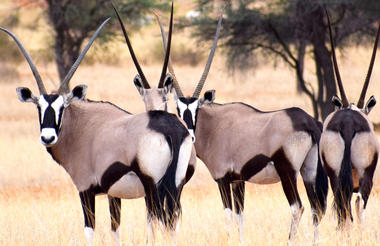
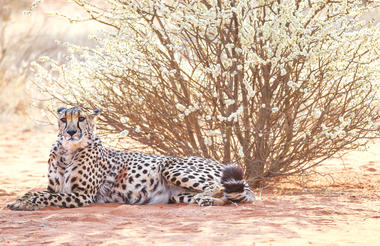

Bidding farewell to the tar roads you turn west and head to the edge of the escarpment. En route you travel past huge cattle and sheep farms (on average in this area 12 – 15 thousand hectares in size) and encounter Camelthorn trees supporting the huge Sociable Weaver nests. These tiny birds build communal nests that can house hundreds of birds. At the edge of the escarpment you have a panoramic view down onto the desert plains with the distant dune fields glowing orange on the horizon. Continue south to reach your overnight accommodation on the edge of the Namib Dune Sea mid afternoon.
Overnight on a half board basis at Namib Desert Lodge
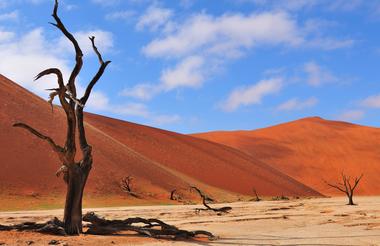
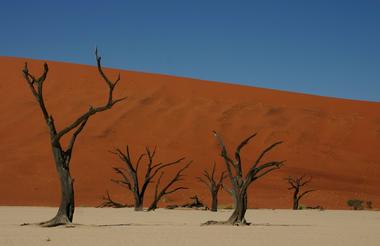
An early wake up is recommended this morning to explore the dune fields of the Namib. Travel a short distance north to reach the entrance gate to Sossusvlei and drive deep into the dune fields. What appear to be mountains in the early morning light are revealed by the suns rays as towering dunes. Rising 1000 feet above the plains the dunes of the Namib are simply stunning! Early morning is the best time to explore the dunes, the soft light offers excellent photographic conditions while the rising sun creates depth and contrast. When the road ends you continue our exploration of the dunes by foot or you can utilize the services of the 4x4 shuttle (not included). Explore stark white pans, dotted with ancient dead Camelthorn trees surrounded by towering orange dunes. On the way back to the lodge you can explore the small but beautiful Sesriem canyon where the history of the ancient Tsauchab River is etched on the canyon walls.
Overnight on a half board basis at Namib Desert Lodge
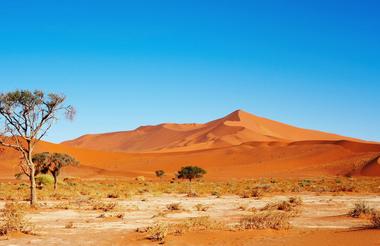
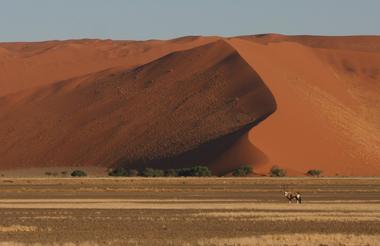
A long but interesting day today. The Namib is a desert of great contrast, offering dunes, rocky canyons and vast gravel plains. As you near the coast the temperature begins to drop. The cold Benguela current moderates the coastal temperatures and creates the life-sustaining fogs that drift inland. On the plains you find vast fields of amazing lichens and the weird and wonderful Welwitchia Mirabilis, a dwarf tree unique to the Namib Desert and which has a lifespan of up to 1500 years. Driving along the rim of the undulating Moonvalley you reach the coastal town of Swakopmund late this afternoon. Founded in 1892 during the period of German colonial rule, Swakopmund served as the territory’s main harbor for many years. Today this historical desert town, surrounded by desert and sea, is a popular destination with a Bavarian flare.
Overnight on a bed and breakfast basis at Sandfields Guest House
A full day to explore Swakopmund and the surrounding areas. The town offers good opportunities for shopping and we suggest a stroll around the town, a visit to the semi-precious stone shops, the art galleries, bookshops and the tannery. The two coastal towns are also the adrenaline centers of Namibia with a variety of activities on offer. Join a marine cruise on the quiet waters of Walvis Bay where you will encounter our marine life, including curios seals, endemic dolphins, pelicans and flamingos. For the lucky few sightings of the strange Mola Mola (Sun Fish) basking in the bay is a highlight and whales (after which the bay is named) are slowly returning to these protected waters. Scenic flights along the coast offer a birds eye view of the desert and are the only way to view the shipwrecks in this area. Other activities include available include quad biking, dune boarding, dune ski-ing, sky-diving, para-gliding, horse & camel riding.
Overnight on a bed and breakfast basis at Sandfields Guest House
This morning you travel up the desolate Skeleton Coast to reach Cape Cross, home to a large colony of Cape Fur Seals. It is an incredible sight to see hundreds of thousands of seals lolling on the beach and frolicking in the water. The population of the colony varies according to season between 60 000 to 100 000 seals! Cape Cross is also of historical importance as it was here that the first European explorers set foot on the coast of Namibia. In 1486 the Portuguese explorer Diego Cao landed at Cape Cross. Turning inland you head across the plains entering an area locally referred to as Damaraland (Kunene region). The scenery changes and the temperature once again increases as you move inland. Travel via Uis and Brandberg Mountain to reach Khorixas this afternoon
Overnight on a half board basis at Damara Mopane Lodge
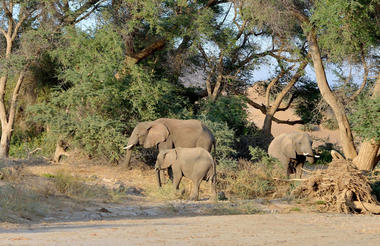
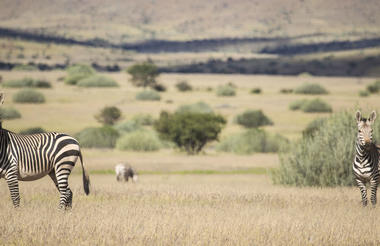
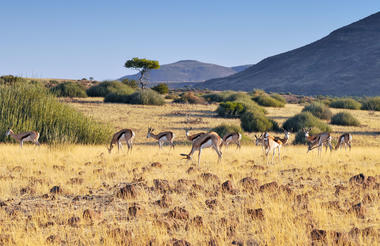
We suggest an early departure today as there is a lot to see and do. Travel north west to reach the Petrified Forest where ancient logs estimated to be 240 million years old lie in the hot semi-desert terrain. Continuing your reach Twyfelfontein, the largest collection of rock engravings in southern Africa. You continue into northern Damaraland, an area of stunning natural beauty and home to the elusive desert adapted elephant as well as a host of weird and wonderful plants. You arrive late afternoon at the remote town of Opuwo, far from the German colonial influences, a true African town!
Overnight on a half board basis at Opuwo Country Lodge
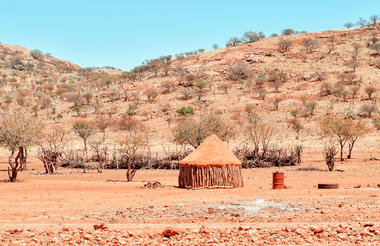
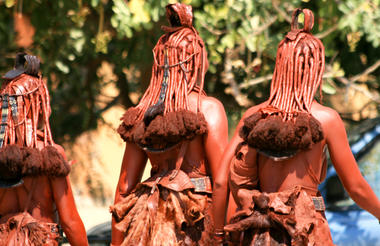
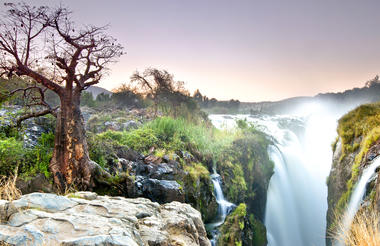
Turning north you enter the area formerly referred to Owamboland now affectionately called the Four “O” region. The four “O”s referring to the regions names: Ohangwena, Omusati, Oshana and Oshikoto. The Owambo ethnic group dominates in this area and is the largest ethnic group in Namibia. The Owambo people are said to have originated in West Africa, in an area that is part of present day Nigeria and Cameroon. You journey across northern Namibia with its characteristic sandy plains dotted with clumps of Makalani Palms, Oshana’s (pans), traditional homesteads and colorful cuca (local beer) shops. The northern part of Namibia is quite different in that there are many people and much activity compared to the rest of the country. The area around Oshakati and Ondangwa has a population density of 300 people per square kilometer compared with two people per square kilometer in the rest of Namibia!
Overnight on a half board basis at Ongula Village Lodge
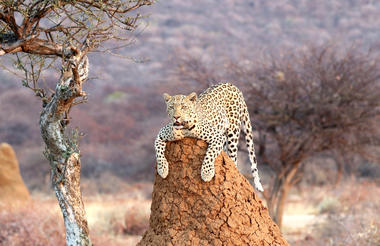
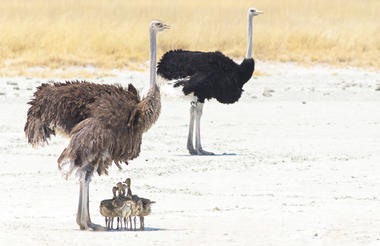

A short drive this morning takes you to Etosha National Park. Etosha, or “the great white place” owes its unique landscape to the Etosha pan, a vast shallow depression of approximately 5000 square kilometres. A series of waterholes along the southern edge of the pan attract game into the area. The dry season (May – December) is particularly rewarding for game viewing as the rain water has dried up and the game is forced to rely on the life supporting waterholes. Long lines of zebra, wildebeest, kudu, oryx and springbok plod along ancient paths from distant grazing areas to the waterholes. Herds of elephant drinking huge amounts of water and then wallow in the water so that all the other the thirsty animals have to wait patiently till they have finished. Predators such as lion and leopard wait at the waterholes knowing the antelope have to drink.
Overnight on a bed and breakfast basis at Mokuti Lodge
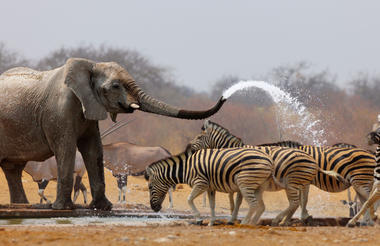
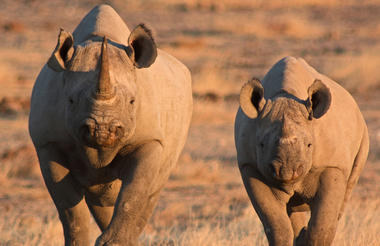
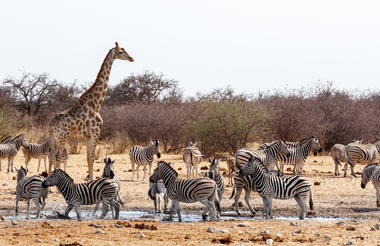
A full day for game viewing in Etosha National Park. This great park is home to 114 species of mammals including the rare and endangered black rhino and black-faced Impala. Predators include lion, leopard, cheetah and hyena. The antelope species vary from the giant eland to the tiny Damara Dik Dik, while herds of dainty springbok, comical wildebeest and stately kudu are found throughout the park. A great variety of birds, insects and reptiles are also to be found.
Overnight on a bed and breakfast basis at one of the Etosha Rest Camps
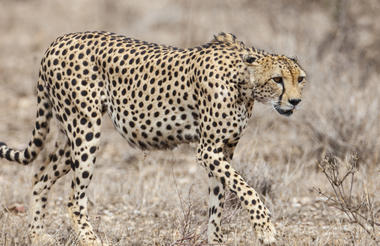
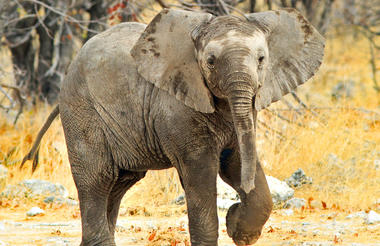
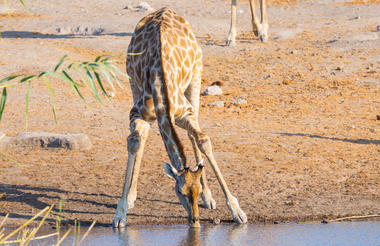
Bidding farewell to Etosha you head south via Otjiwarongo to reach Waterberg Plateau Park. The Waterberg plateau rises about 200 meters above the surrounding plains. The steep red cliffs of the plateau are particularly beautiful at sunrise and sunset when they glow a deep red. There are several walking trails laid out around the camp and this is the best way to explore the area. The higher rainfall and the small springs around the mountain result in large trees and an abundance of birds. There are no dangerous animals in the areas where the walking trails are laid out. The park offers guided 4x4 game drives to the top of the plateau. These game drives depart early morning and late afternoon. During the Herero Uprising of 1904 the deciding battle between the German colonial forces and the Herero took place at the Waterberg. Reminders of the conflict can be seen in the graveyard near the resort office.
Overnight on a bed and breakfast basis at Waterberg Camp
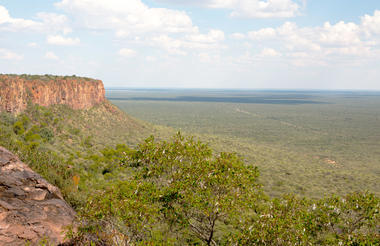
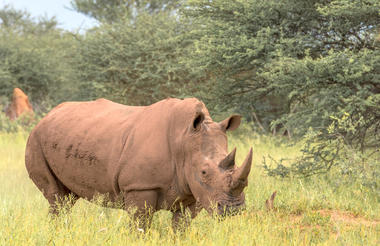
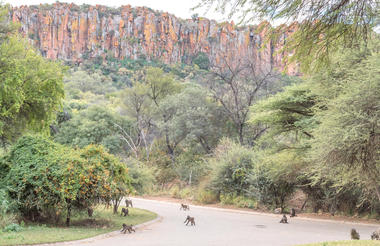
Bidding farewell to Waterberg you head south to Okahandja. This town is of important significance to the Herero people. In 1904 the Herero nation rebelled against the German colonial forces, an uprising that led to many bloody battles in which the Herero suffered great loss of life. Many of the great Herero chiefs are buried in Okahandja and every year the Herero nation gathers to pay homage to their chiefs. On the outskirts of the town is a bustling market where woodcarvers from northern Namibia practice their skills. Spend time wandering around the market, browsing through the stalls with their wooden carvings, baskets and pots before continuing to reach Windhoek and on to Hosea Kutako International Airport to connect with your flight to Johannesburg and onward to New York.
